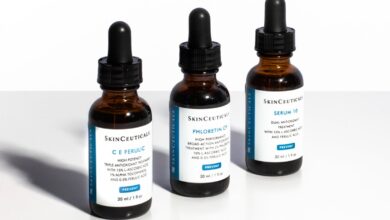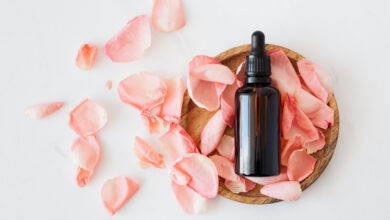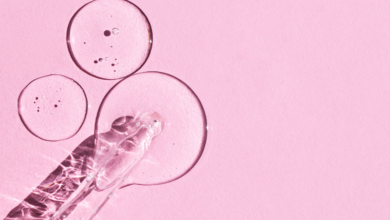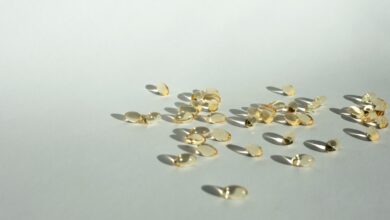
Are you struggling to find the right acids for your skin? Look no further! In this article, we will explore all you need to know about AHA (Alpha Hydroxy Acid) and BHA (Beta Hydroxy Acid). These powerful skincare ingredients can work wonders for your complexion, but understanding which acid is best for your specific skin type is key. Whether you have dry, oily, or sensitive skin, we’ve got you covered. Get ready to unlock the secrets to a radiant and flawless complexion!
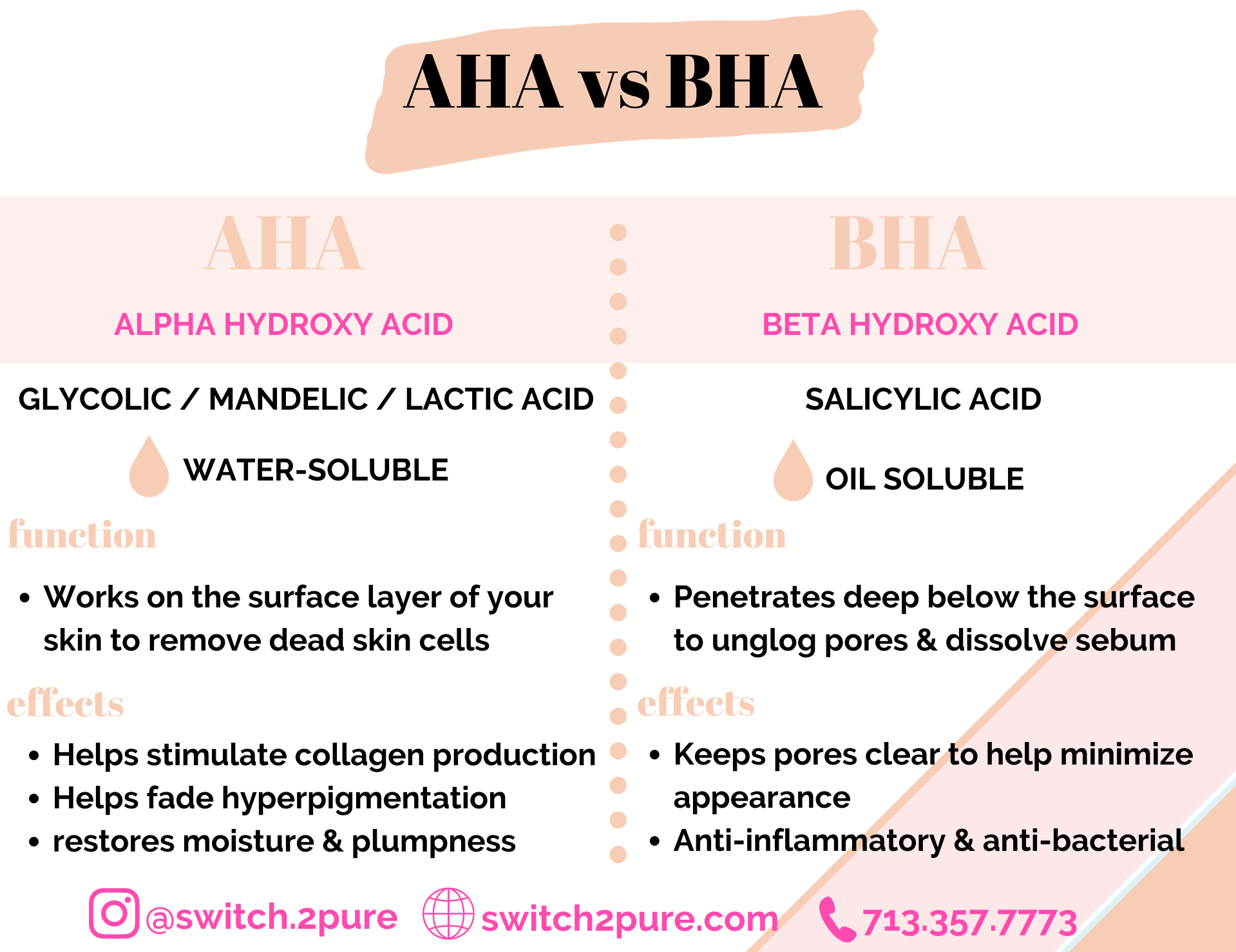
What are AHA and BHA?
AHA and BHA are two types of acids commonly used in skincare products for their exfoliating properties and ability to improve the overall health and appearance of the skin. AHA stands for Alpha Hydroxy Acid, while BHA stands for Beta Hydroxy Acid.
Benefits of AHA and BHA
Exfoliation
One of the main benefits of both AHA and BHA is their ability to exfoliate the skin. Exfoliation is the process of removing dead skin cells from the surface of the skin, revealing a fresher, brighter complexion underneath. AHA and BHA work by breaking down the bonds between dead skin cells, allowing them to be easily sloughed away.
Unclogging Pores
Another benefit of AHA and BHA is their ability to unclog pores. Both acids are able to penetrate the skin and dissolve excess oil and debris that can accumulate in the pores, leading to congestion and breakouts. By keeping the pores clear, AHA and BHA can help prevent the formation of blackheads, whiteheads, and other types of acne.
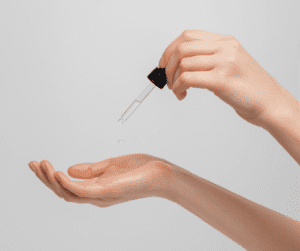
Improving Skin Texture
AHA and BHA can also help improve the texture of the skin. By exfoliating away dead skin cells and unclogging pores, these acids can smooth out the skin’s surface and reduce roughness. This can result in a more even skin tone and a smoother, softer complexion.
Reducing Fine Lines and Wrinkles
Both AHA and BHA have been shown to have anti-aging benefits. They can help reduce the appearance of fine lines and wrinkles by stimulating collagen production, which improves the elasticity and firmness of the skin. Additionally, by exfoliating the skin, AHA and BHA can help plump up fine lines and make them less noticeable.

Treating Acne and Acne Scarring
AHA and BHA are particularly effective at treating acne and acne scarring. By exfoliating the skin and unclogging pores, these acids can help prevent and reduce acne breakouts. They can also fade acne scars and hyperpigmentation by promoting cell turnover and revealing fresh, new skin.

Differences Between AHA and BHA
While both AHA and BHA offer similar benefits, there are some key differences between the two:
Chemical Structure
AHA is water-soluble and works on the surface of the skin, while BHA is oil-soluble and can penetrate into the pores. This difference in solubility affects how the acids interact with the skin and the types of issues they can effectively address.
Solubility
Due to their different solubilities, AHA is better suited for dry or sun-damaged skin, while BHA is more beneficial for oily or acne-prone skin. AHA can effectively exfoliate dry, flaky skin, while BHA can penetrate oily skin and unclog pores.
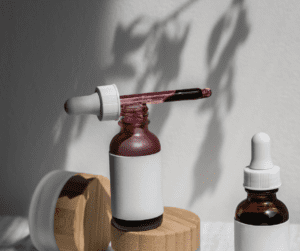
Depth of Exfoliation
AHA primarily exfoliates the surface of the skin, while BHA can reach deeper layers. BHA’s ability to penetrate into the pores makes it particularly effective at targeting acne-causing bacteria and treating clogged pores.
Suitable Skin Types
AHA is generally well-tolerated by most skin types, but it may cause irritation or dryness in some individuals, especially those with sensitive skin. BHA, on the other hand, is usually well-tolerated even by sensitive skin and is recommended for those prone to acne and blackheads.
AHA Types
There are several types of AHAs commonly used in skincare products:
Glycolic Acid
Glycolic acid is one of the most popular AHAs and is known for its ability to penetrate the skin deeply. It is effective at exfoliating the surface of the skin and improving its texture and appearance.

Lactic Acid
Lactic acid is a gentler AHA that is well-tolerated by most skin types. It helps to exfoliate the skin and improve its moisture retention, making it particularly beneficial for those with dry or dehydrated skin.

Citric Acid
Citric acid is a natural AHA derived from citrus fruits. It helps to exfoliate the skin, brighten the complexion, and reduce hyperpigmentation.
Malic Acid
Malic acid is another natural AHA found in fruits such as apples. It has exfoliating and brightening properties and is suitable for most skin types.

Tartaric Acid
Tartaric acid is derived from grapes and has exfoliating properties. It helps to improve the skin’s texture and radiance, making it a popular ingredient in exfoliating treatments.
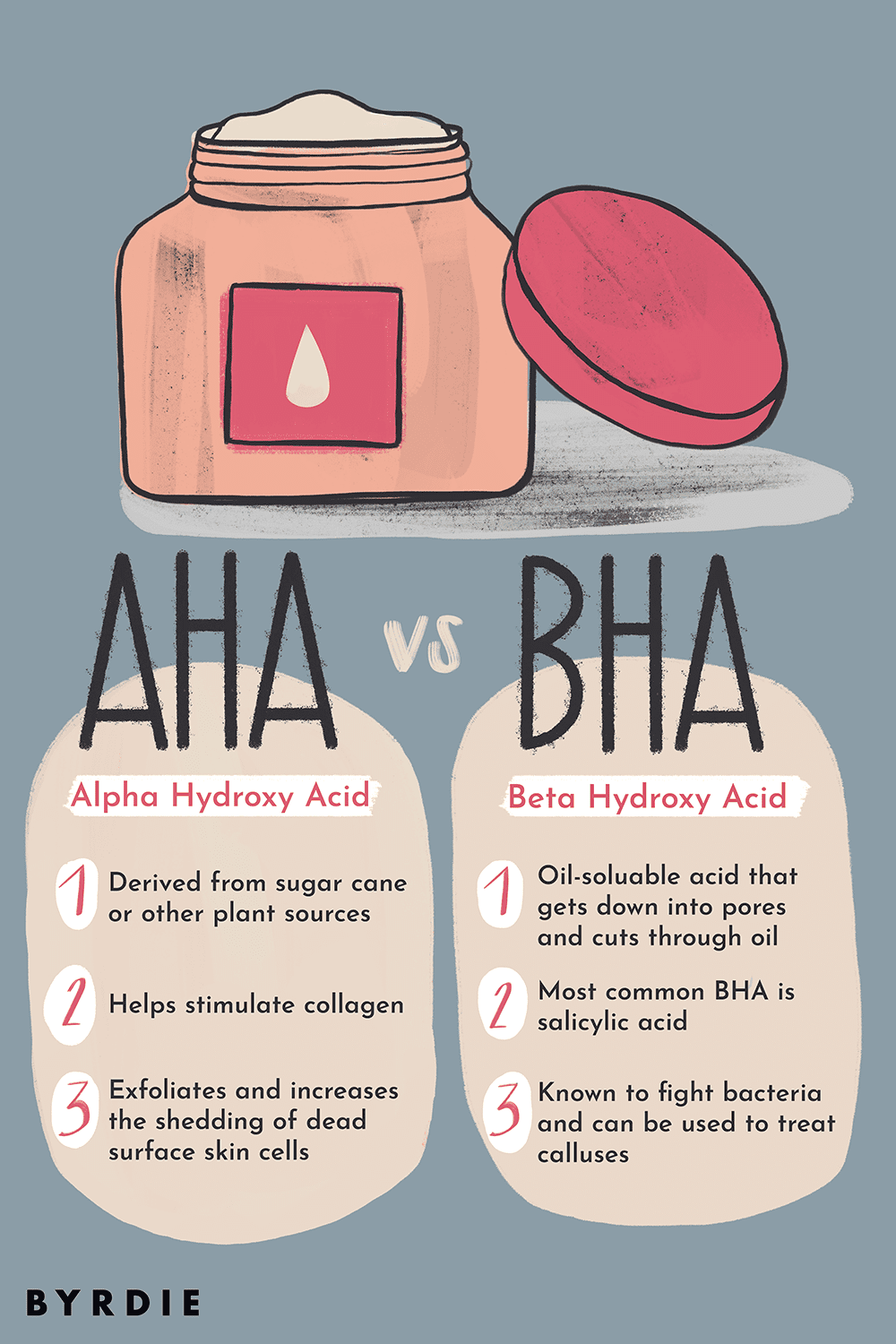
BHA Types
Salicylic acid is the most common type of BHA used in skincare products. It is derived from willow bark and has excellent exfoliating and acne-fighting properties. Salicylic acid can penetrate the pores and help clear out excess oil and debris, making it a popular choice for those with oily or acne-prone skin.
Choosing the Right Acid for Your Skin
When incorporating AHA or BHA into your skincare routine, it’s important to choose the right acid for your skin type:
Dry Skin
If you have dry skin, you may benefit from using a milder AHA like lactic acid or malic acid. These acids can help exfoliate and hydrate your skin without causing excessive dryness.
Oily and Acne-Prone Skin
For oily or acne-prone skin, a BHA like salicylic acid is a great option. Its oil-soluble properties allow it to penetrate the pores and effectively unclog them, reducing the chances of breakouts.
Sensitive Skin
If you have sensitive skin, it’s important to choose a mild AHA like lactic acid or a BHA like salicylic acid that is known for its gentle exfoliating properties. It’s also important to start with a low concentration and gradually increase it to minimize the risk of irritation.
Combination Skin
If you have combination skin, you can tailor your AHA or BHA use to different areas of your face. Consider using a milder AHA or BHA on drier areas while using a stronger one on oilier areas.
Mature Skin
For mature skin, AHAs like glycolic acid and lactic acid can be beneficial. These acids can help improve skin texture, stimulate collagen production, and reduce the appearance of fine lines and wrinkles.
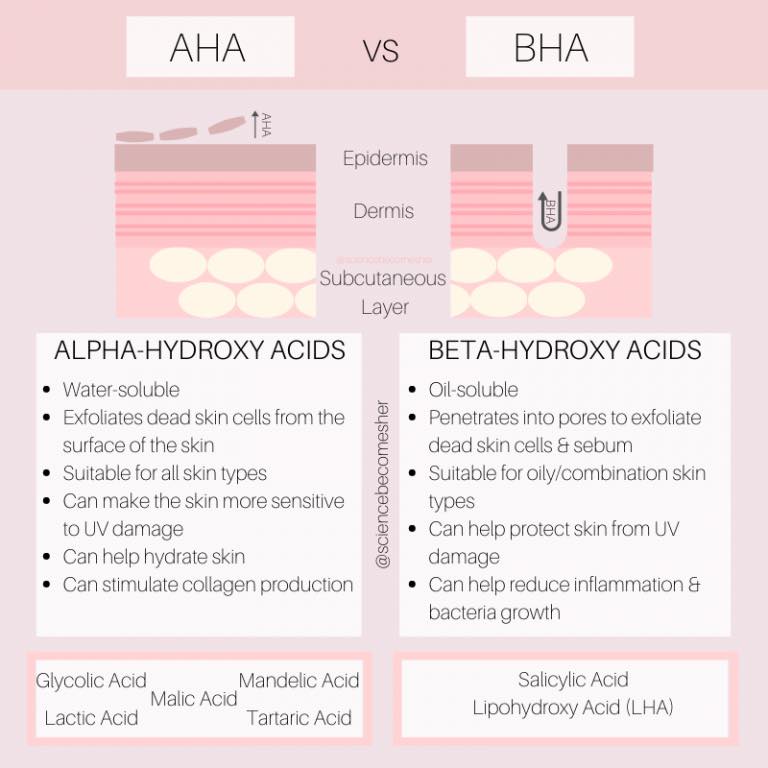
How to Incorporate AHA and BHA Into Your Skincare Routine
When incorporating AHA and BHA into your skincare routine, it’s important to consider your skin’s tolerance and start slowly. Begin by using the acid once or twice a week and gradually increase the frequency as your skin adjusts. It’s also important to follow up with sunscreen as AHAs can increase sun sensitivity.
Potential Side Effects and Precautions
While AHA and BHA can offer numerous benefits to the skin, it’s important to be aware of potential side effects and take precautions:
Sun Sensitivity
Both AHA and BHA can increase the skin’s sensitivity to the sun, making it crucial to apply sunscreen daily to protect the skin from harmful UV rays.
Skin Irritation
In some cases, AHAs and BHAs can cause skin irritation, especially if used in high concentrations or if you have sensitive skin. If you experience redness, stinging, or excessive dryness, it’s important to reduce the frequency or discontinue use.
Pregnancy and Nursing
If you are pregnant or nursing, it’s best to consult with your healthcare provider before incorporating AHA or BHA into your skincare routine, as some acids may not be safe to use during these periods.
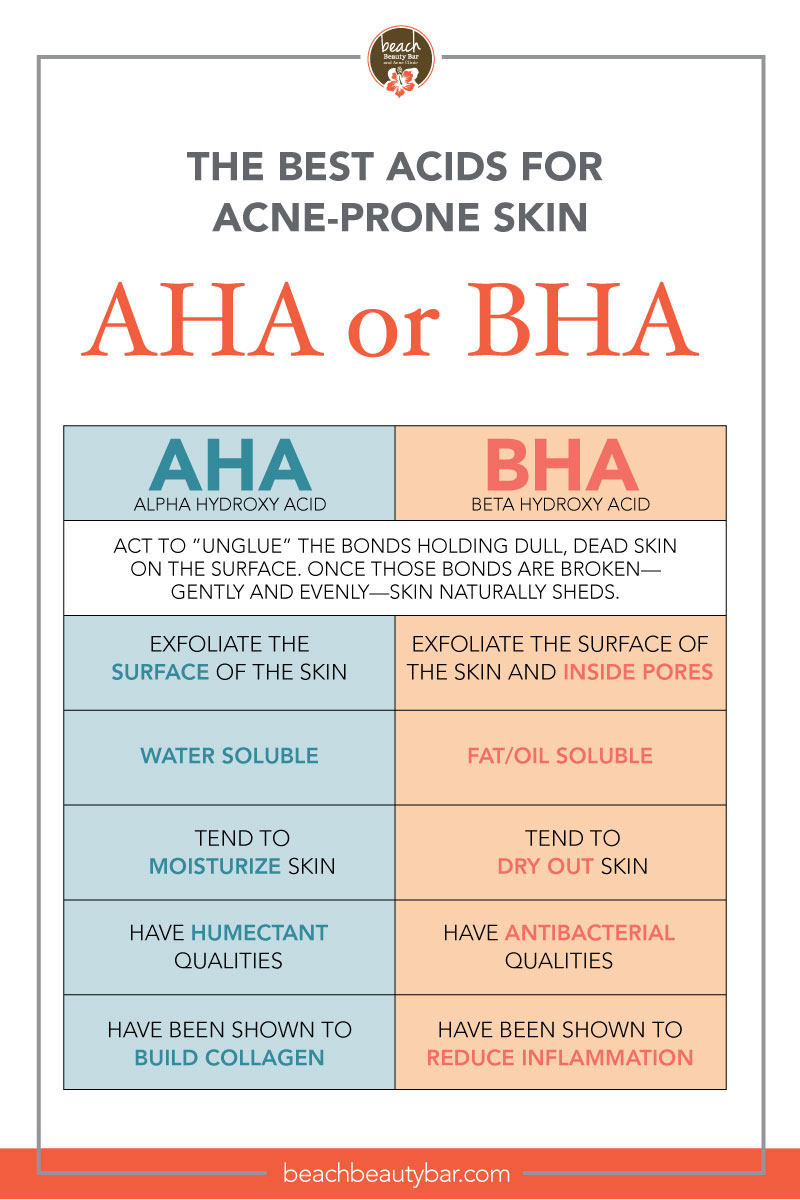
When to Consult a Dermatologist
If you experience severe skin irritation, allergic reactions, or if your skin condition worsens after using AHA or BHA, it’s important to consult a dermatologist. They can provide personalized advice and recommend suitable alternatives or adjustments to your skincare routine.
Conclusion
AHA and BHA are powerful ingredients that can significantly improve the health and appearance of your skin. By understanding the differences between the two, considering your skin type, and following the appropriate precautions, you can incorporate these acids into your skincare routine and achieve a smoother, clearer, and more radiant complexion. Remember, everyone’s skin is unique, so it’s essential to listen to your skin’s needs and adjust your routine accordingly.
THE ORDINARY AHA 30% + BHA 2% Peeling Solution, 30ml Review(Opens in a new browser tab)
THE ORDINARY AHA 30% + BHA 2% Peeling Solution Review(Opens in a new browser tab)
Paula’s Choice Skin Perfecting 2% BHA Gel Review(Opens in a new browser tab)

